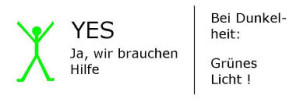Please, take care and be aware of the following:
Especially in the summer season danger might come from:
- traffic:
- many fervent climbing trackers exploit this time of year; correspondingly high is the frequency. Pay special attention to timing, as delays from co-climbers may occur. Also regard others; unleashing of stones may cause detrimental effects. Protect yourself from falling stones.
- weather:
- Tendency for thunderstorms is high in summer, a weather change might occur literally in minutes.
- clothing/food supply:
- sun protection and adequate drink supply are essential. Summery conditions might tempt you into reducing backpack size. But a quick weather change in alpine altitudes will show how a wind jacket/pocket mac is an absolute must on any tour.
- Before you venture out inquire about actual weather conditions at the pit-face..
BEEING IN THE MOUNTAINS
Even with meticulous preparation concerning weather surveillance you could still get caught in an alpine storm. There’s plenty of general advice!
- Despite the threatening thunder – DON’T PANIC! Stay cool and mediate that to the whole rope team.
- If there is no chance to get from the ferrata, keep your cabs locked in. You should never risk a downfall. You might be affected even by the side effects and if not locked in …
- Observe the weather carefully and look for shelter in time. It’s hazardous when a bluish shine appears on metallic objects eg. mountain peak cross or when a tingling sensation on the skin i.e.. ruffled up hair, occurs. This means you’re in field of extreme voltage.
- When in a group – look for shelter separately, don’t stay together! That’s not alway psychological easy, but it’s essential. Pay attention to this advice as its of great importance..
- If possible leave the steal rope and seek a safe place. By no means risk a fall.
- Shelter is found in …
- a trough, a hollow way, a cave;
- inside the forest, but not next to solitary trees;
- on a flat field by sitting on the ground; a closed foot position is important;
- of strickable objects, keep at least a 3 meter distance.
- Within the limits of your possibilities – Keep away from:
- peaks, crests, watery furrows;
- solitary trees, small tree group, rocks;
- edges of forest which has high trees;
- in the vicinity of vertical wall;
- metallic fences;
- metallic equipment (if possible and only then separate and deposit it within a secure distance)
You can find further information on lightning dangers at Austrian Lightning Detection
Raised risk of falling rocks is in spring! Some parts of the climbing routes are not cleaned then. The freezing and melting cycle loosens even the firmest rock.
- Increased danger of rock fall:
- Above us are ibexes, red deer, chamois and the routes are often heavily populated. Even the cautioust of climbers might loosen a stone which can become fatal for the followers, even when they are protected by a helmet.
- Therefore be cautious, watch the vicinity, listen (listening to music on headphones impairs your perceptions). Make yourself and the group realize this so that others aren’t endangered by your rock fall.
- Great danger comes from rope teams. As their dangling ropes over edges or rocks loosens stones easily.
IN CASE | emergency call | signal | helicopter
| EUROPE | 112 |
RESCUE TEAM
|
Accident notification
| WHO |
| WHERE |
| WHAT |
| HOW MANY persons involved |
| WHEATHER CONDITIONS |
| Whom to inform |
In case the mobile phone fails …
| lamp (or blowing a whistle) | ||||
| signal to call for help |
|
|||
| answer |
|





